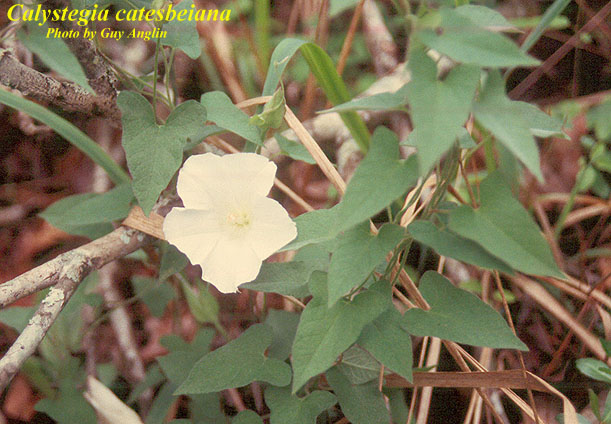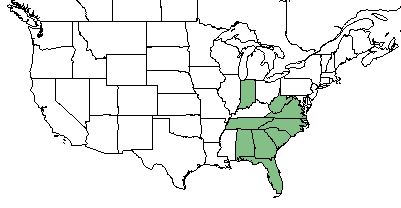Difference between revisions of "Calystegia catesbeiana"
| Line 36: | Line 36: | ||
===Phenology=== <!--Timing off flowering, fruiting, seed dispersal, and environmental triggers. Cite PanFlora website if appropriate: http://www.gilnelson.com/PanFlora/ --> | ===Phenology=== <!--Timing off flowering, fruiting, seed dispersal, and environmental triggers. Cite PanFlora website if appropriate: http://www.gilnelson.com/PanFlora/ --> | ||
| − | ''C. catesbeiana'' has been observed flowering | + | ''C. catesbeiana'' has been observed flowering from March to May.<ref name = "PanFlora"> Nelson, G. PanFlora: Plant data for the eastern United States with emphasis on the Southeastern Coastal Plains, Florida, and the Florida Panhandle. www.gilnelson.com/PanFlora/ Accessed: 16 MAY 2018 </ref><ref name= "Herbarium"/> |
<!--===Seed dispersal===--> | <!--===Seed dispersal===--> | ||
<!--===Seed bank and germination===--> | <!--===Seed bank and germination===--> | ||
Revision as of 19:33, 29 March 2019
Common name: Catesby's Bindweed
| Calystegia catesbeiana | |
|---|---|

| |
| Photo by the Atlas of Florida Plants Database | |
| Scientific classification | |
| Kingdom: | Plantae |
| Division: | Magnoliophyta - Flowering plants |
| Class: | Magnoliopsida - Dicots |
| Order: | Solanales |
| Family: | Convolvulaceae |
| Genus: | Catystegia |
| Species: | C. catesbeiana |
| Binomial name | |
| Calystegia catesbeiana Pursh | |

| |
| Natural range of Calystegia catesbeiana from USDA NRCS Plants Database. | |
Contents
[hide]Taxonomic Notes
Synonyms: Calystegia spithamaea; Calystegia sericata (House) Bell; Convolvulus sericatus House; Convolvulus spithamaeus Linnaeus var. pubescens (Gray) Fernald
Subspecies: Calystegia catesbeiana Pursh ssp. catesbeiana; Calystegia catesbeiana Pursh ssp. sericata (House) Brummitt
Description
C. catesbeiana is a perennial forb/herb and vine of the Convolvulaceae family native to North America. [1] Stems erect or decumbent, rarely twining; lvs to 5 cm long, basally lobed; corollas white, to 5 cm long and wide; flrs axillary from lower axils only. [2]
Distribution
C. catesbeiana can be found in the southeastern corner of the United States. [1]
Ecology
Habitat
C. catesbeiana proliferates in longleaf pine savannas, marsh edges, and openings in dry to dry-mesic montane forests.[3] It has also been observed in slightly distubed areas in forests (tree-fall, etc.), moist rich clay loam, shaded loamy sand, and a roadside depression.[4]
Phenology
C. catesbeiana has been observed flowering from March to May.[5][4]
Conservation and Management
C. catesbeiana is listed as endangered by the Florida Department of Agriculture & Consumer Services, Division of Plant Industry. [1]
Cultivation and restoration
Photo Gallery
References and notes
- ↑ Jump up to: 1.0 1.1 1.2 USDA Plant Database https://plants.usda.gov/core/profile?symbol=CACA101
- Jump up ↑ Coile, N. C. (2000). Notes on Florida's Regulated Plant Index (Rule 5B-40), Botany Contribution No. 38, 3nd edition. Gainesville, Florida, Florida Deaprtment of Agriculture and Consumer Services, Division of Plant Industry.
- Jump up ↑ Weakley, A. S. (2015). Flora of the Southern and Mid-Atlantic States. Chapel Hill, NC, University of North Carolina Herbarium.
- ↑ Jump up to: 4.0 4.1 Florida State University Robert K. Godfrey Herbarium database. URL: http://herbarium.bio.fsu.edu. Last accessed: March 2019. Collectors: Loran C. Anderson, Wilson Baker, Bill Boothe, Marcia Boothe, R. Kral, Richard S. Mitchell, and Gil Nelson. States and Counties: Florida: Jackson and Leon. Georgia: Thomas. Alabama: Talladega.
- Jump up ↑ Nelson, G. PanFlora: Plant data for the eastern United States with emphasis on the Southeastern Coastal Plains, Florida, and the Florida Panhandle. www.gilnelson.com/PanFlora/ Accessed: 16 MAY 2018